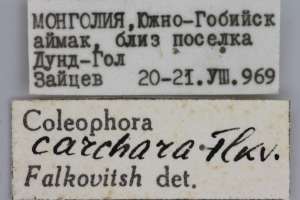

 +5Kontinente:EUAS
+5Kontinente:EUAS3. Biologie
3.1. Nahrung der Raupe
Noch unbekannt! Angesichts der taxonomischen Nähe zu Coleophora salicorniae ist zu erwarten, dass die Art an Salicornia oder verwandten Gattungen (inkl. Atriplex und Chenopodium) der Amaranthaceae lebt.
4. Weitere Informationen
4.1. Andere Kombinationen
- Carpochena carchara (Falkovitsh, 1972) [so bei Sinev (2019)]
4.2. Faunistik
Die Art wurde aus dem Süden der Wüste Gobi in der Mongolei beschrieben. Sie wurde auch im direkt an den Norden der Mongolei angrenzenden asiatischen Teil Russlands nachgewiesen. Sinev (2019: 84) meldet sie dort von "27" (Republik Burjatien) und "28" (Region Tschita) sowie - mit Fragezeichen - aus "25" (Republik Tuva).
Aarvik et al. (2017: 85) führen sie in ihrer "Nordic-Baltic Checklist of Lepidoptera" für Lettland, was bedeutet, dass sie auch in Europa gefunden wurde. Savenkov & Šulcs(2004: 54) vermerkten: "Dgp.: Slutišķi 13-21.08.1996 1 m. - in light trap (NS). This apparently new species for Europe was obtained in the light-trap in the valley of Daugava river. The trap was situated near the farm, which is on the base of a high (about 30 m) slope of the valley. The nearest biotope is dry pine forest edge with steppen vegetation like Artemisia vulgaris, A. campestris, Solidago, Rumex spp., Chenopodium and Atriplex." Und natürlich machten sich die Autoren Gedanken darüber, wie das damals nur aus der Mongolei bekannte Tier nach Lettland kam: "As the migrations of Coleophora-species are not approved in this region, the find of C. carchara may be the result of climate changes. Passive migration with strong eastern winds also is not excluded." Die Möglichkeit, dass das Tier einfach passiv verschleppt worden sein könnte, wurde nicht diskutiert.
25 Jahre gab es keinen weiteren Nachweis mehr in Europa, dafür wurde die Art in China nachgewiesen. Die nächste Überraschung erfolgte aus Polen, von wo Buszko et al. (2022) unter der Überschrift "Coleophora carchara Falkovitsh, 1972 (Lepidoptera: Coleophoridae) – the second record from Europe" meldeten: "2♂♂, Krzywe [FE39] (54º04’50,23”N 23º00’19,92”E), 6.08.2016, A. Krzysztofiak leg. Moths were attracted to a stationary light trap equipped with mercury vapor bulb 250 W." Und wieder diskutieren die Autoren darüber, wie die neuen Nachweise zu bewerten sind: "Coleophora carchara Falkovitsh has been described after specimens collected in the southern part of the Gobi Desert in Mongolia (Falkovitsh 1972). It was also found in China (Li & Zheng 1998). In Europe one specimen was collected in 1996 in Latvia (Savenkov & Šulcs 2004), and the second site has just been discovered in north-eastern Poland. It can be assumed that the species was accidentally introduced to eastern Europe, because there is a huge disjunction between the localities in Europe and its native area in Asia. It seems that the species is not very expansive as it has only been found in two places within 20 years. However, it can be expected in other sites in NE Poland."
Die beiden Fundorte im Süden Lettlands und Nordosten Polens liegen rund 350 km auseinander. Noch ist unklar, ob es sich um zwei unabhängige Verschleppungen gehandelt hat, oder ob die Art im Nordosten Europas (mittlerweile) etabliert ist. Da in Polen gleich 2 Exemplare gefunden wurden, ist eine erfolgte Etablierung durchaus wahrscheinlich. Doch noch bleiben hier viele Fragen offen. Ohne Nachweise in Kasachstan, im Westen Russlands, in der Ukraine oder in Belarus ist die Idee der Arealerweiterung oder der Verdriftung über starke Winde - bei einem räumlichen Abstand von 4500 oder auch 5000 km - nichts als pure Spekulation. Eher spricht hier doch etwas für passive Verschleppung. Der zweite (und dritte) Nachweis in Europa zeigt aber, dass es sich im Osten Europas lohnen könnte, auf diese Art zu achten. Bis zur Klärung wird für die beiden europäischen Länder vorerst das Einzelnachweis-Symbol verwendet. Barcoding könnte hier helfen, abzusichern, dass es sich in der Mongolei und in Europa tatsächlich um die gleiche Art handelt.
(Autor: Erwin Rennwald)
4.3. Typenmaterial
Falkovitsh (1972: 708): “Голотип, ♂, Южко-Гобийский аймак, пески Хонгорын-Элс, 60 км ЗСЗ Баян-Далая, 30-31 УП 1967 (Кержнер). Паратипы: 2 ♂, там же, 30-31 УП 1967 (Кержнер); 12 ♂, Южно-Гобийский аймак, поселок Дукд-Гол, 20-21 УШ 1969 (Гурьева, Зайцев, Кержнер, Козлов); 5 ♂, Южно-Гобийский аймак, 20 км западнее колодца Барун-Бугатын-Худук, 25-27 УШ 1969 (Гурьева, Кержнер).”
4.4. Literatur
- Aarvik, L., Bengtsson, B.Å., Elven, H., Ivinskis, P., Jürivete, U., Karsholt, O., Mutanen, M. & N. Savenkov (2017): Nordic-Baltic Checklist of Lepidoptera. — Norwegian Journal of Entomology - Supplement No. 3: 1-236. [PDF auf entomologi.no]
- Buszko, J., Rynarzewski, T., & A. Krzysztofiak (2022): Coleophora carchara Falkovitsh, 1972 (Lepidoptera: Coleophoridae) – the second record from Europe. — Annals of the Upper Silesian Museum in Bytom Entomology, 31: 1-3. http://doi.org/10.5281/zenodo.5835526. [PDF auf muzeum.bytom.pl]
- Erstbeschreibung: Фалъкович, М. И. (1972): Новые виды чехлоносок (Lepidoptera, Coleophoridae) из пустыни Гоби [New species of casebearers (Lepidoptera, Coleophoridae) from the Gobi Desert]. — Насекомые Монголии 1: 693-714.
- Li H. & L. Zheng (1998): Studies on the Chinese Coleophoridae (Lepidoptera): Coleophora salicorniae group, with descriptions of twelve new species. — Entomologica Sinica, 5: 189–221. [Sekundärzitat]
- Savenkov, N. & I. Šulcs(2004): New and rare Lepidoptera for the Latvian fauna. — Baptria, 29 (2): 52–58.
- Синёв, С. Ю. [ed.] (2019): Катапог чешуекрылых (Lepidoptera) России. Издание второе [Sinev, S. Yu. (ed.) (2019): Catalogue of the Lepidoptera of Russia. Second edition]: 1-448.









